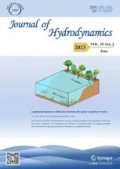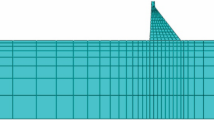Abstract
The hydraulic parameter quick test system in accordance with the oscillation principle can overcome the shortcomings of traditional methods in determining hydraulic parameters which, besides having complex hydrogeological restrictions and needing complex equipment in the field, are often both time and energy consuming, and high cost. Based on the hydrogeological conditions in the north anchorage of Taizhou Yangtze River Highway Bridge, a quick hierarchical test is carried out for different depths of single-hole drilling to verify the function of the system in this case. Meanwhile, with a purification of the raw data gathered in the test by wavelet denoising, the hydraulic parameters are worked out by adopting the Kipp model. A comparison between the Kipp model results and stratigraphic data as well as pumping test results justifies the reliability and accuracy of the new method. The study finds other advantages of the method like high efficiency in operation, flexibility in stratified test, as well as environmental-friendliness. Therefore, the technology is of significant practical value and application prospect.
Similar content being viewed by others
References
HUANG Yong, ZHOU Zhi-fang and DONG Zhi-gao. Simulation of solute transport in fractured network with a probability method[J]. Journal of Hydrodynamics, 2009, 21(5): 714–721.
FU Jun-feng, JIN Sheng. A study on unsteady seepage flow through dam[J]. Journal of Hydrodynamics, 2009, 21(4): 499–504.
ZHANG Pei-wen, LIU De-fu and SONG Yu-pu. Coupling simulation of surface flow and subsurface flow over porous media[J]. Journal of Hydrodynamics, Ser. B, 2004, 16(3): 283–289.
ZHOU Zhi-fang, JIN Zhong-qing. An analytical method for calculation of 3D unsteady well flow in leaky aquifers[J]. Journal of Hydrodynamics, Ser. A, 2000, 15(3): 329–336(in Chinese).
CHEN Bing, CHENG Liang. Numerical investigation of three-dimensional flow and bed shear stress distribution around the span shoulder of pipeline[J]. Journal of Hydrodynamics, Ser. B, 2004, 16(6): 687–694.
MA Xiu-yuan, LI Shu-guang and ZHU Wei-shen. A new method in groundwater flow modeling[J]. Journal of Hydrodynamics, 2009, 21(2): 245–254.
ZHANG Qian-fei, LAN Shou-qi and WANG Yan-ming et al. A new numerical method for groundwater flow and solute transport using velocity field[J]. Journal of Hydrodynamics, 2008, 20(3): 356–364.
YU Ming-hui, DENG Yin-ling and QIN Lian-chao et al. Numerical simulation of levee breach flows under complex boundary conditions[J]. Journal of Hydrodynamics, 2009, 21(5): 633–639.
VITALY A. Z., VIRGINIA L. M. Multi-level slug tests in highly permeable formations: 1. Modification of the Springer-Gelhar (SG) model[J]. Journal of Hydrology, 1998, 204(1–4): 271–282.
VITALY A. Z, VIRGINIA L. M. Multi-level slug tests in highly permeable formations: 2. Hydraulic conductivity identification, method verification, and field applications[J]. Journal of Hydrology, 1998, 204(1–4): 283–296.
ZEMANSKY G. M., MCELWEE C. D. High-resolution slug testing[J]. Ground Water, 2005, 43(2): 222–230.
MCELWEE C. D. Improving the analysis of slug tests[J]. Journal of Hydrology, 2002, 269(3–4): 122–133.
ÖZGEN K. C., GERRIT G. Hydraulic conductivity changes and influencing factors in longwall overburden determined by slug tests in gob gas ventholes[J]. International Journal of Rock Mechanics and Mining Sciences, 2009, 46(7): 1162–1174.
ERIK S., TODD S. and LAWRENCE C. M. Analysis of the hydromechanical behavior of a flat-lying fracture during a slug test[J]. Journal of Hydrology, 2007, 347(1–2): 35–47.
HANGSEOK C. Numerical model for analyzing slug tests in vertical cutoff walls[J]. Journal of Geotechnical and Geoenvironmental Engineering, 2007, 133(10): 1249–1258.
JAMES J. B. J., ELIZABETH J. G. and JOHN M. H. Analysis of slug tests in formations of high hydraulic conductivity[J]. Ground Water, 2003, 41(5): 620–630.
ZHOU Zhi-fang, WANG Zhong-xia and ZENG Xin-xiang et al. Development of rapid field test system for determining permeable parameters of rock and soil masses[J]. Chinese Journal of Rock Mechanics and Engineering, 2008, 27(6): 1292–1296(in Chinese).
BEIJING E-FECIT INFO.-TECH. CO., LTD. Wavelet analysis theory and MATLAB7 realization[M]. Beijing: Electronic Industry Press, 2005(in Chinese).
Author information
Authors and Affiliations
Corresponding author
Additional information
Project supported by the Jiangsu Province College Graduate Research and Innovation Program (Grant No. CX08B_123Z), the Fundamental Research Funds for the Central Universities (Grant No. 2009B11814).
Biography: ZHAO Yan-rong (1979-), Male, Ph. D. Candidate, Lecturer
Rights and permissions
About this article
Cite this article
Zhao, Yr., Zhou, Zf. A Field Test Data Research Based on a New Hydraulic Parameters Quick Test Technology. J Hydrodyn 22, 562–571 (2010). https://doi.org/10.1016/S1001-6058(09)60089-5
Received:
Revised:
Published:
Issue Date:
DOI: https://doi.org/10.1016/S1001-6058(09)60089-5




